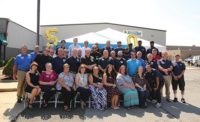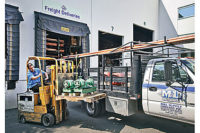Custom homes can be a double-edged sword for wholesalers supporting design-build contractors.
While working on any complex installation, there’s great opportunity to build a lasting relationship with installers by becoming an asset, to install trust in a brand, and raise the installers overall confidence through superior support.
On the flip side, providing that extra level of support needed to overcome unique obstacles, work around changes that occur during construction, and making sure that the installer understands exactly what the work entails can be difficult at times.
Typically associated with ample budgets, a custom residence can serve as a blank canvas for the installer that enjoys freedom of creativity, focusing on the art of design and the potential for premium comfort. For wholesalers, the same applies, as does the possibility of providing material from a variety of different product lines that might not be required in the average home.
Two years ago, Ferguson Enterprises’ VRF division, in Secaucus, New Jersey, became involved with a system design at a 10,000-square-foot, new-construction residential project in Paramus. Already well along in the design process, the home featured sweeping stairways, spacious rooms, finished third-story spaces and an indoor pool.
“The homeowner wanted in-floor heat, so we knew from the beginning that there would be two independent systems. Three, if you count the natatorium system,” says Karol Tomaszewski, VRF sales and technical advisor at Ferguson. “For air-conditioning and shoulder-season heat, we supplied several Fujitsu Airstage VRF systems.”
Flexibility in design
The home’s radiant system is designed as the primary heat source for the bulk of the winter. Two condensing boilers – one on either side of the home – serve more than 20 zones throughout. Gypcrete was used to create a lightweight slab over the tubing on the upper levels of the house. The hydronic system also supplies heat to the natatorium through a hot-water coil in the Dectron dehumidification system.
The VRF system includes 11 zones to ensure efficient operation, controllability and comfort. Limited access above the ceiling required a very
flexible design.
“The size of this home, along with the framing and floorplan, created a unique set of challenges for the installing contractor, who had never used VRF in a residential application,” Tomaszewski explains. “They sought our help to quote and design the system.”
Beyond the additional considerations needed for a VRF system over mini-splits, there was a need for extended line-set lengths, even though ducted evaporators were used extensively.
Three-phase power was not available at the site, so large, V-series Airstage systems weren’t an option. Yet the flexibility of serving numerous zones of different sizes across the large home still was needed without installing condensers all over the home’s perimeter.
“We initially looked at the J-II Airstage systems, comparing the line’s capabilities to the needs of the home,” Tomaszewski says. “Because the J-II can support a total connected pipe length of 590 feet, two, five-ton systems were needed to accommodate the longest runs.”
As the design was refined, Tomaszewski and Fujitsu Sales Engineer Umair Surani realized that instead of using J-II systems across the entire project, costs could be trimmed by using the new J-IIs models where line-set lengths were shorter. The system has a total connected pipe length of 260 feet. As a result, two of these were ordered, at three tons each.
The backyard of the horseshoe-shaped home will include a beautiful courtyard complete with multi-level hardscaping and a grand staircase. To keep this space free of mechanical equipment, two VRF condensers were installed on either side of the home.
Comfort and control
“Even though the units were installed on opposite sides of the home, some the refrigerant lines are still quite long, Tomaszewski elaborates. “Using a VRF system gave us the flexibility to provide 11 zones to an intricate blueprint without many condensers. This couldn’t have been accomplished with mini-splits or conventional unitary equipment.”
Low, medium and high-static air handlers are all used, depending on the space. Several vertical ducted condensers are used in the basement, and the garage is conditioned by an 18,000 Btu/h wall-hung unit.
There’s a total of 28 indoor units. Refrigerant splitters are used where zones include more than one head.
All zones and units, aside from the boilers and Dectron unit, are controlled and monitored by a Ventacity SBC (smart building controller). The SBC provides the owner, service contractor, wholesaler or engineer with remote access.
“Because the SBC is BacNet capable, connecting the SBC to the hydronic and natatorium systems is possible,” Tomaszewski adds. “But it decided to let those elements stand alone on this project.”
Control is provided through the Fujitsu Service Tool built into the SBC. This provides an-depth technical view into the system as it operates, displaying all information such as all temperature readings, refrigerant pressure readings, compressor amperage, etc. Each is continually recorded.
“The distributor, Wales Darby, came to the site early-on, as did a few Fujitsu personnel during the SBC installation,” Tomaszewski says. “Robert Inderwise, one of our commissioning agents, also helped with start-up. Once his commissioning process is complete, he can determine that the system is installed and operating as intended. This allows Fujitsu to confidently issue its extended 10-year warranty.”
Simplifying the submittal process
“I began this project by sitting down with the installer and the homeowner and listening to their expectations,” Tomaszewski says. ”We discussed zoning, particularly how the owner wanted to break up the many different zones for air-conditioning purposes.
This information, along with plenty of data provided by the general contractor, was entered into Fujitsu’s VRF Design Simulator. “If you can create the system in the Design Simulator, the system will work in the field,” Tomaszewski explains. “The program then creates a complete design and submittal package, including high- and low-voltage wiring schematics, a refrigerant piping diagram, and a materials and equipment list.”
The homeowners were actively involved with the entire project, and requested a number of changes to both the floorplan and the HVAC systems before the home was completed this May. Using a VRF system permitted Ferguson and the installer a great deal of flexibility that would’ve been more difficult with unitary systems. Line-set lengths were changed more than once, as were the size and style of the evaporators.
“This job would’ve looked a lot different 20 years ago, or even 10,” Tomaszewski concludes. “It’s amazing to see how HVAC technology has evolved, and also how the levels of comfort and efficiency have soared.”






